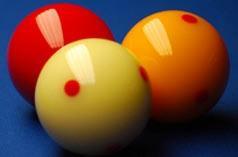
The game of 3-Cushion Billiards is believed to date back to the 1870's, although the exact origins remain both unknown and in dispute. The fascination we players have with the game is undeniable, and the challenge in solving shot patterns has helped the game endure and thrive despite the great difficulty it presents to master. Even if you never lift a cue, watching the game will fill you with awe, especially when a top level player makes the cue ball do things you never imagined were possible!
The object of the game is simple. A player uses a wooden cue stick to strike his white or yellow cue ball so that it contacts the other two balls (his opponent's and the red ball) and at least three cushions. For the point to count the cue ball must touch any combination of cushions at least three times before touching the second object ball, hence the name 3-Cushion Billiards. The most common pattern is for the cue ball to strike the first object ball. then three cushions in succession, before striking the second object ball. But it is possible to strike all three cushions first, followed by the two object balls in succession. And there are many more possibilities. In fact the cue ball may even strike 5, 6, or more cushions before striking the second object ball. Or strike the same cushion three or more times before reaching the second object ball. All these patterns can yield a valid point for the player.
Enjoy this short video from New York player Ira Lee, a computer programmer and billiard enthusiast, who provides some great examples of the different ways a point can be scored in 3-Cushion Billiards:
Complete rules of the game both for International play sanctioned by the UMB, and for play in tournaments sanctioned by the United States Billiard Association can be found by clicking the following links:
